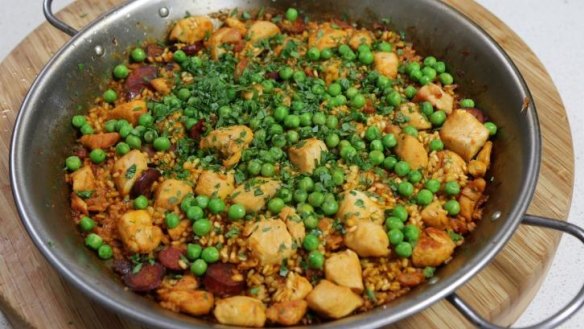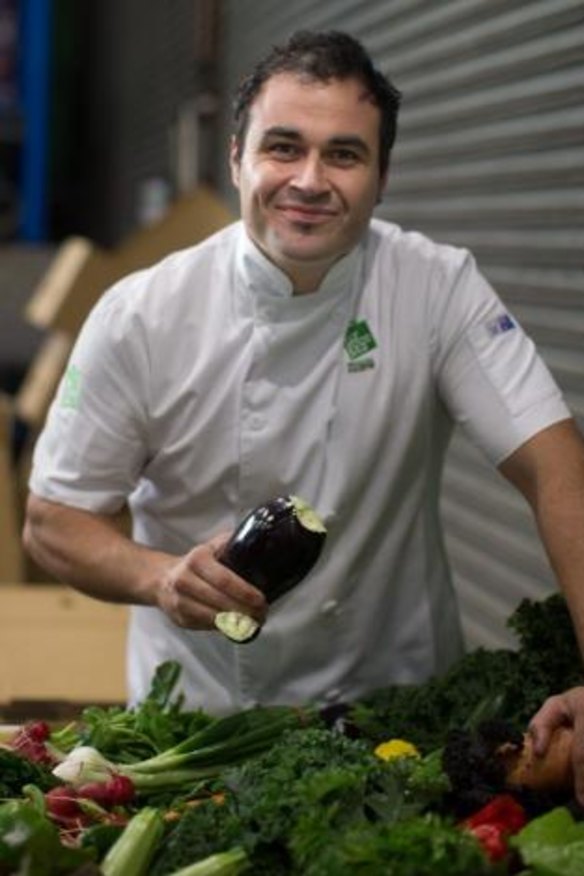Miguel Maestre's perfect paella

The first rule when it comes to making paella is that you're not allowed to cook it unless you can pronounce it properly, says chef Miguel Maestre.
The Spaniard who calls Sydney home is only half-joking. "It's paella [pah-ey-uh]," laughs Maestre, who co-hosts TEN's The Living Room.
"Paella is the most iconic Spanish dish. What pizza and pasta are to the Italians is what paella is to the Spanish. I love paella. It's a real family dish and defines where I come from," says Maestre, who was born in Murcia in the south of Spain.

Most etymologists agree paella was created in the Spanish city of Valencia and is a happy marriage between two cultures: the Romans, for the pan, and the Arabs, for the rice.
Paella is prepared by simmering chicken or seafood with rice, vegetables, saffron and other seasonings. Maestre says he has made it his mission to see the Spanish dish a staple in kitchens around his adopted country. While those with Spanish ancestry will have different versions of the dish, here's how to master his version.
Get started
Maestre says many home cooks stumble at the first hurdle in that they are too intimidated to even try the dish and wrongly perceive it to be exceedingly difficult.
"Paella is the opposite of intimidating. It's home cooking at its very best. The Spanish make it look like a restaurant dish but it's actually an everyday meal that is accessible and affordable," he says.
Preparing to cook the paella
Maestre says paella is typical of traditional home cooking in Spain because it can be ready in about 20 minutes. The key to pulling together a paella is to have all the ingredients laid out on the bench and ready to go before you start.
"You don't want to be looking for the paprika when you are cooking the paella."
The sofrito
Maestre says the sofrito - that aromatic mixture of caramelised onions, garlic and tomatoes - is at the heart of the paella, lending a lovely texture and real richness of flavour to the dish.
"I want people to make paella, so my version of the recipe is about keeping it simple while maintaining that authentic taste," he says. "I want to make it easy for people to achieve. For example, I recommend putting all the ingredients for the sofrito in a food processor - the tomatoes, piquillo peppers, garlic, parsley, chives, oil, saffron and paprika - to make it less fiddly to prepare."
While Maestre concedes many people insist on adding the saffron strands to the warm stock to infuse, he insists it's perfectly acceptable to add the fragrant strands to the sofrito and then add it direct to the pan.
"People muck about with saffron too much. Sure you can put it in the stock and all that rubbish but you can also stop thinking about being a genius and just add it to the pan and cook it," he says.
The importance of the pan
Despite being named after the dish it is cooked in, Maestre argues it's not essential to use a proper paella pan if not having one deters you from cooking the dish. If you are going to improvise, opt for a flat wide pan, he says.
Maestre's personal preference for a paella pan is one made of stainless steel, round, a flat, dimpled base. The size of the pan will depend on the number of people you want to serve and must take into consideration the size of your oven or cooktop.
"Having a flat, wide pan with a thin base is very important. You don't want the rice to be too thick. If there is no conduction of heat, there is no evaporation, which means the rice will not cook evenly," he says.
It's possible to make do with a flat frying pan as the most important thing is that it will fit over your stove top so the rice has maximum contact with the bottom of the pan. If you have a lot of guests and a large pan, he suggests using more than one burner and rotating the pan in order to control the distribution of heat.
The classic paella pan made of carbon steel requires a little more care to prevent it from oxidising but is popular with professional paella cooks as it develops a patina over time that Maestre says imparts a certain flavour to the dish.
"The height is the most important element about the pan as the rice must have maximum contact with the bottom of the pan to achieve the soccarrada [the crust at the bottom of the pan]. The Spanish say that the rice should be only as thick as the width of one finger and spread in an even layer," he says.
The type of rice to use
Short-grain rice is best as it absorbs liquid easily and won't dry out. And, unlike risotto, stirring the rice is strictly forbidden. Maestre says any self-respecting Spaniard uses Bomba rice in their paella, a variety grown near the village of Calasparra and renowned for its quality and ability to absorb 1½ times as much water as regular rice varieties without turning mushy.
"Bomba is the ultimate paella rice because the starch is so strong that you can cook it and cook it and it holds its shape. The most common mistake people make when cooking paella is to use the wrong rice. Why? You wouldn't use Singapore noodles for fettuccine would you?" he says.
Soccarrada success
Ask any proud paellero (paella cook) and they'll tell you that the soccarrada is what separates an average cook from a maestro. Maestre says the crisp, golden layer that forms on the bottom of a paella is regarded as a highly prized delicacy in Spanish households.
"Colour means flavour and the soccarrada caramelises the flavours from the garlic and the paprika and that strong flavour is going to give you extra layers of flavour. In every home in Spain, the kids always fight for the soccarrada and the oldest brother always gets the most," he says.
So how do you achieve soccarrada success? "After 15 minutes, when all the stock is gone and you finish cooking your paella turn the heat up and look at the bottom of the pan and see if the rice is sticking. Cook it on high for two minutes and then turn off the heat and rest it for five minutes. That extra five minutes will make all the difference to the paella as the flavours will settle and it will taste fantastic."
Taking stock of your ingredients
If the sofrito is the heart of the paella, the stock is what makes the dish sing. And while Maestre's first choice is for a quality home-made stock, he'd rather see people cook the dish than worry about whether they've slaved over a stock made from scratch.
"Aussies get so stressed about paella. I'm here to say, 'relax'. If you don't have a home-made stock, use a good-quality bought stock. It doesn't matter. Cooking paella should be free. Use whatever you want to. You can use chicken, seafood, vegies, squid ink or whatever you like because it's meant to be a home-cooked dish. Throw out the rule book and just cook," he says.
"If you do want to make a home-made stock, just quickly boil up some of the fish bones and prawn shells before getting started."
Troubleshooting
Two common mistakes are not adding enough stock to the dish or overcrowding the pan. Maestre says you can always top up the dish with additional stock if it has evaporated ahead of the recommended cooking time. To minimise failure, don't overcrowd the pan. "If the pan is too crowded the rice will be cooked at the bottom and raw on top. You also need to rest the pan to ensure all those lovely flavours are allowed to develop."
Cleaning a paella pan
Never scrub a paella pan. Wash it carefully with hot water only, clean and dry really well. If you have a carbon steel paella pan, apply a little bit of olive oil so it does not rust.
Miguel Maestre has launched a make-at-home kit, Paella a la Maestre,available at Woolworths. Paella pans are available at Victoria's Basement, Peter's of Kensington, GrandCucina.com and Salt Meats Cheese.
Paella a la Maestre
Serves 3-4
500g marinara mix (mussels, fish, calamari, prawns, scallops)
Splash of extra virgin olive oil
500ml chicken stock
220g Bomba rice
50g fresh or frozen peas
1 lemon, cut into wedges, to serve
½ bunch chives, garnish
Aioli and Sangria, to serve
For the sofrito
2 large ripe tomatoes, roughly chopped
6 piquillo peppers
4 garlic cloves, peeled, crushed
½ bunch parsley
1 bunch chives
25ml extra virgin olive oil
1 pinch saffron threads
1 tbsp smoked paprika
To make the sofrito, place all the sofrito ingredients in a food processor and process until chunky. If you don't have a food processor, roughly chop the tomatoes and piquillo peppers and finely chop the garlic, parsley and chives then combine with other sofrito ingredients in a mixing bowl.
Place a 30-centimetre-wide frying pan or paella pan over a high heat. Add the marinara mix with a splash of extra virgin olive oil and cook for one minute. Add sofrito and cook for a further three minutes. Add chicken stock and bring to the boil. Stir in rice and bring to a simmer on medium to low heat for 15 minutes until stock has absorbed.
Add peas and cook for a further two minutes to achieve "soccarrada" (crust on the bottom of the pan).
Season to taste with salt and garnish with chives. Squeeze over lemon juice just before serving. Serve with aioli and sangria, the Spanish way. Ole!
The best recipes from Australia's leading chefs straight to your inbox.
Sign up